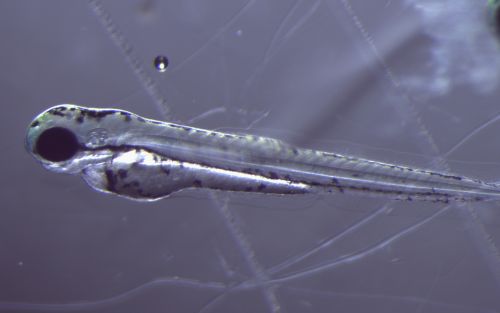New Research Reveals How Chemical Exposure Affects Developing Zebrafish
A team of University of North Texas and NOAA scientists uncover novel neurologic effects in addition to cardiac effects in early stage zebrafish exposed to polychlorinated biphenyls (PCBs), expanding on available science relevant to natural resource damage assessments.
JUNE 9, 2025 — A 2025 publication, “Exposure to the Polychlorinated biphenyl mixture Aroclor 1254 elicits neurological and cardiac developmental effects in early life stage zebrafish (Danio rerio),” reports on research carried out by the University of North Texas, NOAA’s Office of Response and Restoration Assessment and Restoration Division, and other partners. The paper evaluates the effects of the PCB mixture Aroclor 1254 on the early life stages of zebrafish. This research builds on existing studies examining how PCBs affect fish.
“This work is a great example of how a university works with a federal agency in a research partnership,” says Aaron P. Roberts, Ph.D., a professor within the Department of Biological Sciences at the University of North Texas and senior author of the publication. “The results of the work are important for assessment of chemicals in the environment, and interactions with federal scientists provide university students real-world experience needed for the job market.”
Legacy contaminants, such as PCBs, bioaccumulate through the food chain from invertebrates to fish and wildlife, causing harm to both wildlife and humans who consume a contaminated organism. These contaminants can negatively affect development, growth, and reproduction of organisms in the ecosystem. Zebrafish (Danio rerio) are a common environmental toxicological model species, making them ideal for comparisons across multiple studies.
The goal of this study was to compare the bioaccumulation of different doses of Aroclor 1254 in zebrafish embryos to associated cardiac and neurologic outcomes under different test conditions. Establishing effect concentrations for cardiac and neurotoxic effects of PCBs in early life stage fish is challenging due to the non-reporting of measured concentrations in fish eggs for lab experiments, the lack of standard exposure methods, and the difficulty conducting experiments with PCBs. By reporting tissue concentrations in fish embryos, this research will support standardization across different tests and may improve the accuracy of effect threshold estimates.
The results of this study showed:
- novel neurologic effects (eye tremors) in zebrafish exposed to PCBs,
- cardiac effects (brachycardia, pericardial edema) from exposure to Aroclor 1254 are much less than elicited by PCB 126, confirming results from other studies,
- and the importance of measuring PCB concentrations in water (exposure medium) and receptors (fish tissue).
These findings underscore the importance of understanding how legacy contaminants like PCBs continue to affect aquatic life at critical stages of fish development as scientists work to protect and restore ecosystems impacted by hazardous waste and oil spills.
 An official website of the United States government.
An official website of the United States government. 
